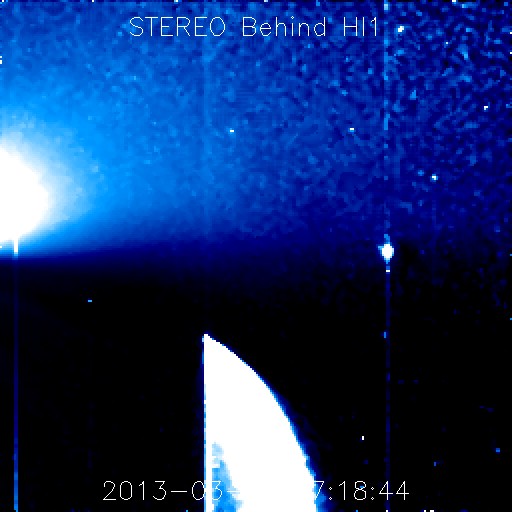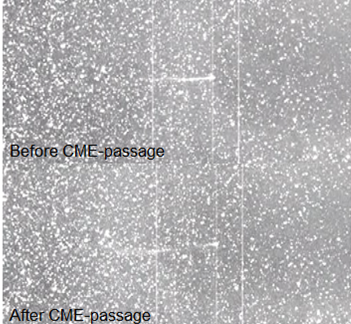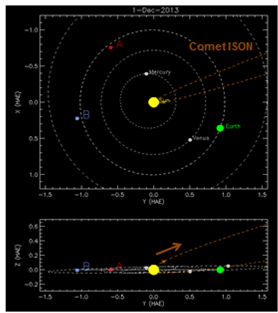From the darkness of outer space, comet Pan-STARRS has come to pay us a one-time visit before receding again into the coldness of oblivion.
The comet, officially designated as C/2011 L4, was discovered in June 2011 by the Pan-STARRS telescope on Hawaii when it was still over 1 billion kilometers away from the Sun. Last Sunday, on 10 March, the comet was closer to our home star than the planet Mercury.
You'd expect that, being so close to the Sun, the comet would be visible in the coronagraphs of the solar satellites. Indeed, SOHO in particular has proven to be a true comet catcher, having discovered more than 2000 (mostly sun-grazing) comets. Alas, Pan-STARRS'orbit is such that it will not show up in any of the coronagraphs onboard SOHO or the STEREO-spacecraft.
As it turns out, the comet will only be visible in the Heliographic imager (HI-1) of Stereo-Behind, which is pointed away from the Sun to better track the evolution of coronal mass ejections as they travel towards Earth. These images are in white light, so all visible features (except the stars) are reflecting sunlight. The picture underneath, taken by STEREO-B HI-1 during the morning hours of 12 March, shows the comet as it is moving up in HI-1's field of view. The bright blob to the right is the planet Earth (say "cheese"!). The planet Mercury is hidden by the bright sunlight, and only a spike from saturated HI-1-pixels can be seen to the left of the comet. The transit can be followed at the STEREO-website, and the comet is expected to stay in HI-1's field of view till early next week.

Comets and the Sun have always had an intimate relationship. As a comet approaches the inner regions of our solar system, the solar radiation gradually vaporizes and ionizes material from the comet's nucleus. The dust trails the comet in its orbit, but the ions are driven straight away from the Sun by the solar wind. This leaves a comet usually with two distinct tails, i.e. a dust-tail and a plasma-tail.
Transients in the solar wind as well as the passing-by of a coronal mass ejection (CME) can cause disturbances in the comet's ion tail, sometimes completely ripping it off from the comet. Such a disconnection event was observed by STEREO-Ahead's HI-1 back on 20 April 2007, during the passage of comet Encke (see image underneath and NASA's special for more information and movies). Therefore, space weather specialists keep an eye on comets as their evolution can tell something on the local conditions of the solar wind.

Seen from Earth, the northern hemispherers will now have a front-seat view on Pan-STARRS as the comet will move to higher latitudes. Several websites are providing finder charts e.g. here. The comet is still low above the horizon, giving the observers a hard time finding Pan-STARRS with the naked eye. Small binoculars may turn out to be a very useful help!
Pan-STARRS is considered to be a general repetition for the really big event coming up later this year, when comet ISON (C/2012 S1) promises to give a spectacular display in November and December. The STEREO-website has a special ISON-page that offers a great view on when and where the comet will be visible. Coming closer than 2 million kilometers from the Sun (perihelion on 28 November), ISON will show up in the coronagraphs of all major solar satellites and will even transit the solar disk as seen through the STEREO-A's EUV-imager. It is speculated that the comet -if it survives its close-encounter with the Sun- may briefly become as bright as the full moon! However, experience has shown that it is wise to temper the expectations. Nonetheless, even if comet ISON turns out to be significantly dimmer than predicted, it still has all the potential to bring a great show!

 |
 |





